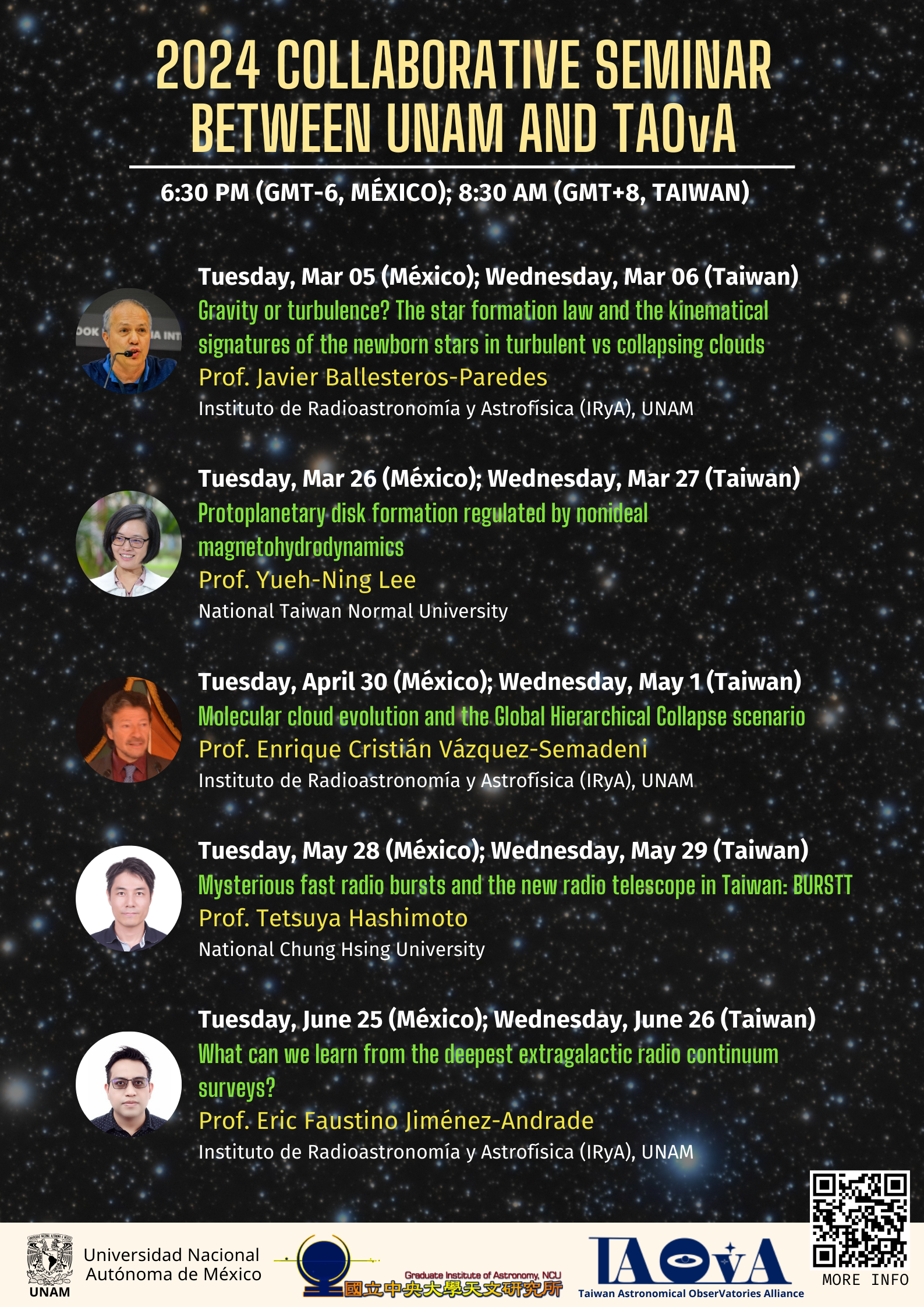2024 Collaborative Seminar between UNAM and TAOvA
 This is an online seminar and will be conducted via Zoom.
This is an online seminar and will be conducted via Zoom.
To gain access to the online link, kindly register here:
https://forms.gle/qGARLQK8D7U8X7vo6
We're very pleased to announce the second talk of the UNAM-TAOvA 2024 Collaborative seminar series. Please find below details of the seminar and the Zoom connection.
Speaker: Eric Faustino Jiménez-Andrade (IRyA)
Data & Time:
Wednesday, June 26 at 08:30 (Taiwan) | Tuesday, June 25 at 18:30 (Mexico)
Title:
What can we learn from the deepest extragalactic radio continuum surveys?
Abstract:
Radio continuum imaging has been a key approach to trace the production of stars and the activity of supermassive black holes at redshifts 0 < z < 5 — a cosmic epoch marked by the dominant fraction of star formation that is obscured by dust. In recent years, our team has pushed the resolution and sensitivity limits of the Very Large Array (VLA) to obtain some of the deepest and sharpest radio continuum images ever obtained, providing unique constraints on the radio morphologies of massive star-forming galaxies at high redshifts. In this talk, I will present updates on the multi-frequency VLA radio surveys in the GOODS-N, Frontier, and CEERS fields that reach sub-uJy sensitivity and sub-arcsecond resolution at 3-10GHz. After summarizing the available data products and initial science results, the talk will focus on the imaging challenges faced to produce and characterize the aforementioned radio surveys. Finally, I will discuss how multi-frequency radio surveys of deep fields will serve as pathfinders for future ngVLA and SKA observational programs. The combination of the unprecedented SKA-ngVLA capabilities will allow us to probe the radio SED of distant galaxies on sub-kpc-scales across three decades of radio frequency, which will be paramount to establish radio continuum emission as a robust indicator of the level and spatial distribution of dust-obscured massive star formation in the early Universe.
ZOOM INFO:
Join Zoom Meeting
https://cuaieed-unam.zoom.us/j/86569370779?pwd=oCOx4ayR8k5fLrgbSkHEhOTafSlEc3.1
Meeting ID: 865 6937 0779
Passcode: 352198
| Wednesday, Mar 06 in Taiwan | Tuesday, Mar 05 in Mexico |
| 08:30 - 09:30 (GMT+8, Taiwan) | 18:30 - 19:30 (GMT-6, Mexico) |
|
Prof. Javier Ballesteros-Paredes (Instituto de Radioastronomía y Astrofísica (IRyA), UNAM) "Gravity or turbulence? The star formation law and the kinematical signatures of the newborn stars in turbulent vs collapsing clouds" |
|
| Tuesday, April 2 in Taiwan | Monday, April 1 in Mexico |
| 08:30 - 09:30 (GMT+8, Taiwan) | 18:30 - 19:30 (GMT-6, Mexico) |
|
Prof. Yueh-Ning Lee (National Taiwan Normal University) "Protoplanetary disk formation regulated by nonideal magnetohydrodynamics" |
|
| Wednesday, May 1 in Taiwan | Tuesday, April 30 in Mexico |
| 08:30 - 09:30 (GMT+8, Taiwan) | 18:30 - 19:30 (GMT-6, Mexico) |
|
Prof. Enrique Cristián Vázquez-Semadeni (Instituto de Radioastronomía y Astrofísica (IRyA), UNAM) "Molecular cloud evolution and the Global Hierarchical Collapse scenario" |
|
| Wednesday, May 29 in Taiwan | Tuesday, May 28 in Mexico |
| 08:30 - 09:30 (GMT+8, Taiwan) | 18:30 - 19:30 (GMT-6, Mexico) |
|
Prof. Tetsuya Hashimoto (National Chung Hsing University) "Mysterious fast radio bursts and the new radio telescope in Taiwan: BURSTT" |
|
| Wednesday, June 26 in Taiwan | Tuesday, June 25 in Mexico |
| 08:30 - 09:30 (GMT+8, Taiwan) | 18:30 - 19:30 (GMT-6, Mexico) |
|
Prof. Eric Faustino Jiménez-Andrade (Instituto de Radioastronomía y Astrofísica (IRyA), UNAM) "What can we learn from the deepest extragalactic radio continuum surveys?" |
|
